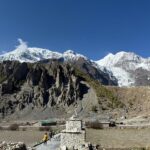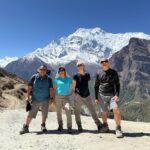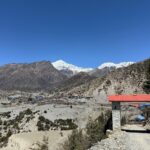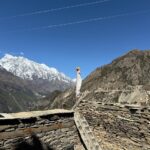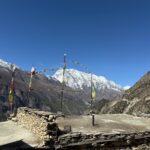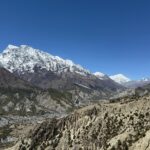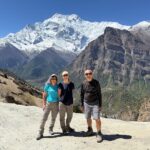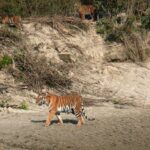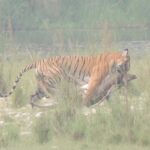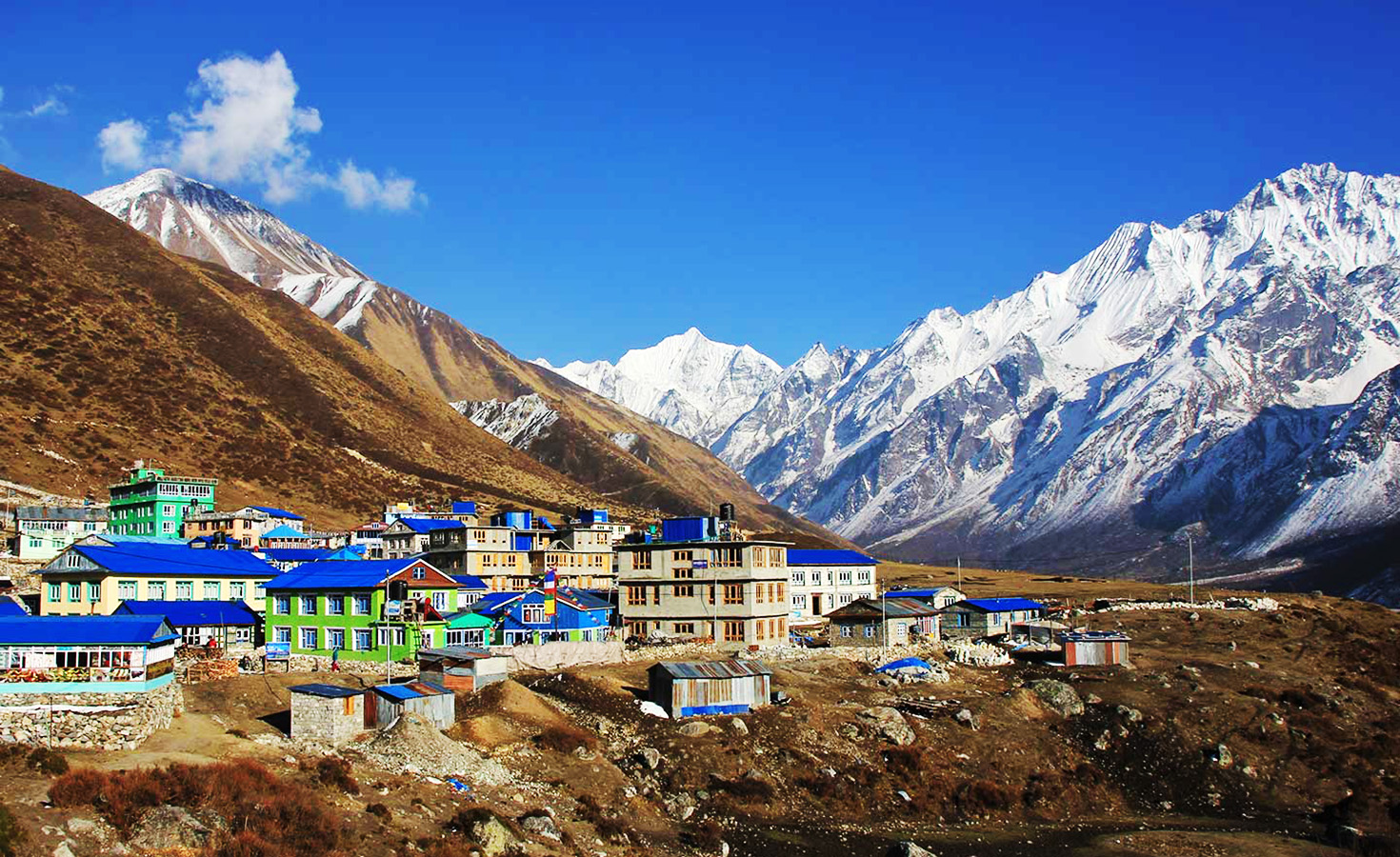
Langtang Valley Trek
The Langtang Valley trek, which is conveniently located near Kathmandu Valley, is a popular destination for many travelers due to its easy accessibility. The Langtang Valley Trek offers a moderate yet rewarding journey through lush forests, picturesque valleys, and alongside glaciers. Experience rich biodiversity, cultural encounters, and stunning Himalayan vistas along the way.Langtang Valley is widely recognized for its awe-inspiring mountain vistas and the genuine warmth of the local Tamang villagers. It is regarded as one of the most magnificent regions in Nepal.
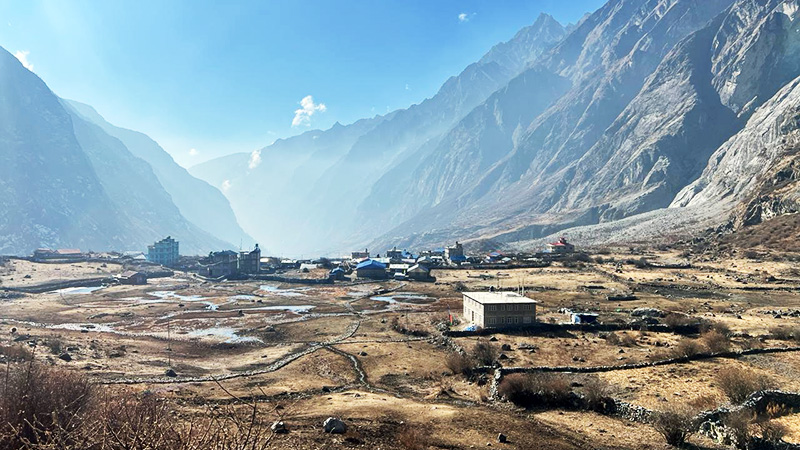
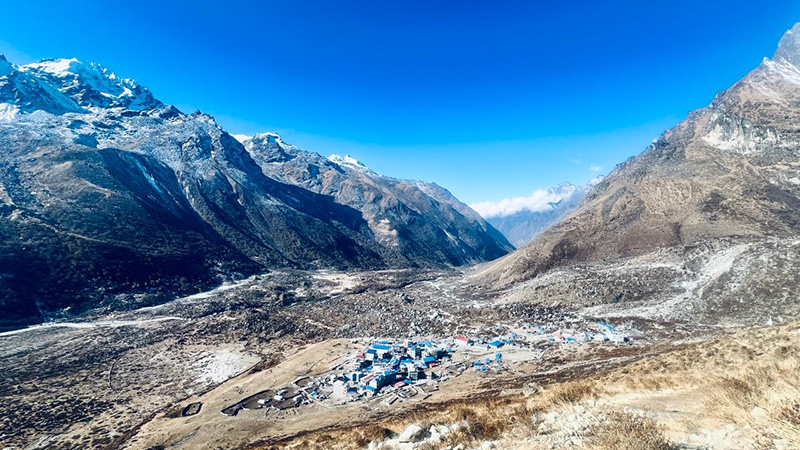
After the 2015 earthquake, which resulted in extensive damage and disrupted tourism, the region has undergone substantial reconstruction. Today, the revitalized villages warmly welcome tourists to this extraordinarily beautiful region, contributing to a significant boost in the local economy.
Langtang National Park is a stunning natural area that spans across different elevations, featuring a wide range of forests covering approximately 25% of its total area. These forests vary from subtropical to alpine, providing a diverse habitat for various plant species. Among the rich flora found in the park, you can discover deciduous oak, maple, pine, and the vibrant rhododendron, which adds a beautiful touch to the landscape during the spring season. Wildlife enthusiasts can look forward to spotting native animals such as the Himalayan black bear, Himalayan Tahr, Assam macaque, and even the elusive red panda. There are ongoing rumors about the possible sightings of the mythical Yeti in this particular region.
The trek takes you to the revered Hindu pilgrimage site of Gosainkunda lakes, which attracts a large number of pilgrims every August. Furthermore, the area is of great importance to Buddhists who make pilgrimages to the renowned Kyanjin Gompa monastery.
The journey begins in Syabru Besi Village and takes you through breathtaking high alpine pastures where yaks peacefully graze, dense forests, and finally concludes at the magnificent Kyanjin Gompa. Embarking on a side trek to Kyanjin Ri (peak) offers trekkers a truly captivating experience, as they are treated to a breathtaking 360-degree view of the majestic Himalayan Mountains. The return journey descends through the valley, concluding with a drive back to Kathmandu. For individuals who have limited time, choosing a helicopter option from Kyanjin can offer a convenient alternative to going back along the trekking route.
When you immerse yourself in the breathtaking Langtang Valley, you will be filled with awe at its stunning beauty and inspired by the unwavering resilience of its mountain communities.
“To walk in nature is to witness a thousand miracles.” By Mary Davis
Langtang Valley Trek some facts
Distance: 77 km or 48 miles
Days Required: 9 days (including 2 days of transit to and from Kathmandu, 7 days of trekking)
Total Incline: 4000 meters
Total Decline: 4000 meters
Highest Point: Kyanjin Ri (4,773m) or Tserko Ri viewpoint (5,033m); Yala Peak (5,500m) is also accessible from Kyanjin Gompa.
Difficulty: The Langtang Valley Trek is shorter than Everest Base Camp or the Annapurna Circuit but comparable in difficulty. Reaching an altitude of 5000m poses a challenge, and altitude sickness can be common. The route involves rapid ascents with several days featuring over 1000m of altitude gain. While suitable for beginners, it requires proper preparation.
Permits: A TIMS card and Park Entrance Permit are required, available for purchase upon entering the park.
Guide: While not mandatory, having a guide is recommended, especially for first-time trekkers in Nepal. A guide manages logistics, directions, distances, and tea house arrangements.
Accommodation: Guest Houses or Tea Houses are available along the route, offering comfortable beds, showers (extra charge), and restaurant facilities. The accommodation is cozy and provides a welcoming environment after a day of hiking. The villages, mostly Tibetan, offer a unique cultural experience.
Table of Contents
- Langtang Valley Trek Major Highlights
- Is Langtang Valley Trek A Challenging Trek?
- The Best Time For Langtang Valley Trek
- How Difficult Is Langtang Valley Trek
- People And Culture Of Langtang Valley Trekking Region
- Why Langtang Valley Trek Is A Rewarding Experience
- Extending Langtang Valley Trek
- What To Pack For Langtang Valley Trek
- Wildlife And Vegetation In Langtang Region
Langtang Valley Trek Major Highlights
1. Snow-Capped Peaks, Lush Forests, and Cascading Waterfalls
The convergence of snow-capped peaks, lush forests, and cascading waterfalls creates a captivating symphony of nature that delights the senses. The combination of icy summits, lush foliage, and flowing water creates a visually stunning experience. By standing beneath towering mountains, wandering through lush forests, or marveling at cascading waterfalls, you will develop a deep appreciation for the beauty of the present moment.
The Langtang Valley trek takes you through a stunning landscape of peaks and mountains, providing a breathtaking variety of mountain panoramas as you make your way up. As I traverse through the dense forest paths and verdant hillsides, the air becomes infused with the earthy aroma of the wilderness, accompanied by the delightful melodies of chirping birds. Graceful waterfalls cascade from great heights, enveloping tired travelers in refreshing misty shrouds that rejuvenate their spirits.
2. A pilgrimage to the sacred Kyanjin Gompa monastery, nestled amidst towering mountains.
Kyanjin Gompa has a rich history that spans several centuries, telling stories of devotion, dedication, and an uninterrupted lineage of spiritual practice. The monastery is adorned with vibrant prayer flags that flutter in the refreshing mountain breeze. Its architecture and artifacts beautifully reflect the long-standing Buddhist traditions that have been nurtured within its walls for generations.
The journey to Kyanjin Gompa holds deep significance for devotees and pilgrims, as it is a sacred odyssey that inspires faith and encourages reflection. Embarking on a trek through awe-inspiring landscapes can greatly enhance one’s sense of devotion and dedication. Engaging in conversations with devoted monks offers valuable insights into their way of life, beliefs, and the teachings they uphold.
3. Embracing the warm hospitality of local Tamang communities.
The Langtang trek offers accommodations that primarily focus on the homestay experience, which is managed by local communities, with a special emphasis on the Tamang people. These lodgings are both simple and welcoming, providing a friendly place for travelers to rest and recharge. Guests can also enjoy delicious local cuisine and have heartwarming conversations with the locals.
The Tamangs, who are the predominant community in the Langtang region and are believed to be descendants of Tibetans, are well-known for their friendly and hospitable nature. Tamangs, with their eagerness to share their culture and way of life, bring a unique and captivating charm to the experience of trekking in the Langtang Valley. Visitors are generously treated to a rich heritage of storytelling, which includes traditional folktales, legends, and historical tales. The genuine care and affection received during a stay with the Tamang people leaves a lasting impact, filling the hearts of travelers with gratitude for their warm hospitality.
4. The picturesque viewpoints.
The Langtang region offers numerous captivating vantage points that showcase stunning panoramic views. Kyanjin Ri, Tserko Ri, and Laurebina La Pass are highly regarded viewpoints that allow trekkers to experience the breathtaking beauty of the Langtang range.
The Langtang Valley trek itinerary offers the opportunity to ascend either Kyanjin Ri or Tserko Ri. In addition, other trekking packages in the Langtang region provide access to viewpoints such as Lauribina La, Ganja La, and many others. These viewpoints are usually the highest points of the trek, offering trekkers breathtaking landscapes and stunning vistas, including mesmerizing sunrises.
5. The rich biodiversity of Langtang National Park.
Langtang National Park is a captivating landscape adorned with lush, dense forests that showcase a remarkable diversity of plant species. As trekkers journey through the rhododendron and oak forests, they are treated to a mesmerizing display of colors that come to life during the spring and early summer seasons.
The park serves as a haven for plant enthusiasts, hosting a wide variety of medicinal plants, aromatic herbs, and rare alpine flowers, creating a botanical paradise. Its rich biodiversity extends to a diverse range of wildlife, with prized inhabitants including the elusive and endangered Red Panda, Himalayan Tahrs, Musk Deer, and more. The elusive snow leopard may be glimpsed by sharp-eyed, experienced trekkers.
For birdwatchers, Langtang National Park offers a true delight, as the trail abounds with exotic birds. From the vibrant Himalayan Monals and Satyr Tragopans to the elusive Golden Eagles and Lammergeiers, the park provides an opportunity to encounter a variety of captivating avian species.
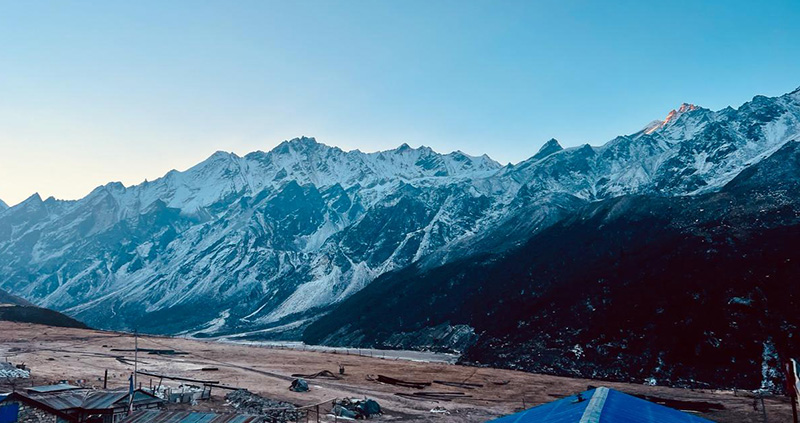
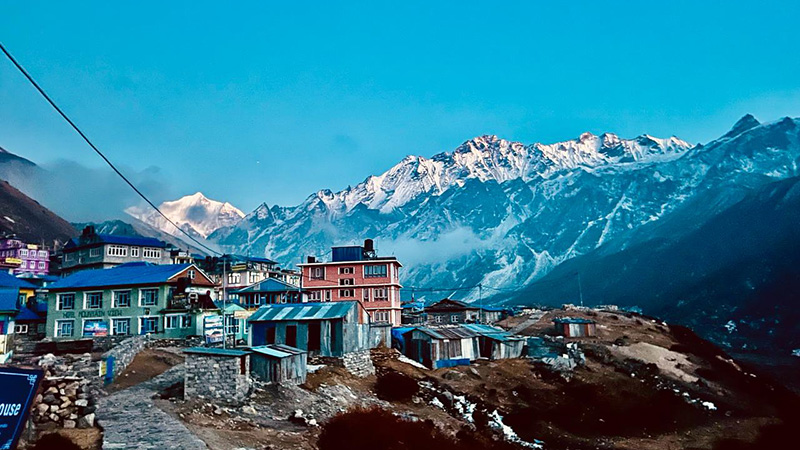
Is Langtang Valley Trek a challenging trek?
The Langtang Valley, situated approximately 61.8 kilometers north of the Kathmandu Valley, is a captivating mountainous region. The Langtang Trek takes you on an exhilarating journey through the scenic valleys of Nepal, leading to the foothills of the Nepal Himalayas.
Renowned for its glacial lakes, vibrant culture, and dense forest trails, the Langtang Valley trek offers an opportunity to witness a breathtaking 360-degree panoramic view of the majestic snow-capped mountains.
In terms of difficulty, several factors influence the trek’s challenge level in Nepal, including weather conditions, altitude, and the trekker’s physical and mental capabilities. The Langtang Trek is considered moderately difficult, suitable for trekkers of all ages with average physical fitness and no prior trekking experience.
However, adequate preparation is crucial before embarking on the trek, considering the unpredictable mountainous terrain. Proper preparation ensures readiness to face potential challenges and difficulties that may arise during the journey.
The Langtang Trek route involves navigating hilly terrain, narrow ridges, and steep slopes along a rugged trail. Covering a distance of 60 to 80 kilometers, trekkers typically walk for 6 to 7 hours daily.
Starting from the village of Syabrubesi at an altitude of 1550 meters, the trail progresses to Lama Hotel. This segment, with occasional steep climbs, takes around 6 to 7 hours. As the trek advances, the trail becomes predominantly uphill, posing a challenge for those new to hiking. The journey to Langtang village spans another 6 to 7 hours.
Continuing to Kyanjin Gompa at 3900 meters, the trek reaches higher altitudes, adding a level of difficulty. While certain sections feature rocky terrain and steep slopes, the enchanting natural beauty enhances the overall experience, making it both enjoyable and rewarding. Trekkers should exercise caution when navigating such challenging trail segments.
The best time for Langtang Valley Trek
The Langtang Valley Trek is best experienced during the months of September to December and March to May when the weather conditions offer clear views of the majestic mountains and vibrant lush forests.
However, undertaking the trek is possible throughout the year, although certain compromises and consequences should be considered. The Langtang region’s weather can undergo significant changes, and during periods of rainfall, there is a high risk of severe landslides.
Temperature fluctuations are common, with the possibility of temperatures dropping below 0 degrees Celsius. Heavy snowfall is also a potential challenge that could lead to trail blockages. Adequate preparation is essential to navigate such situations, including packing warm clothes and jackets. While sleeping bags are not mandatory, having one is highly recommended to ensure a comfortable trekking experience.
How difficult is Langtang Valley Trek
The Langtang Valley Trek is somewhat demanding, making it accessible to many hikers. The highest peak, Tserko Ri or Kyanjin Ri, is 4,984 meters (16,350 feet), however it doesn’t approach the extreme heights of other Nepal climbs. The walk takes 7–10 days, depending on route and pace.
The trail has forested trails, rocky terrain, and steep ascents and descents. Trekkers should expect 5–7-hour days of walking. Avoiding altitude sickness requires acclimatization, especially as you rise into the valley.
The route has simple teahouses and more luxurious lodges in larger settlements like Lama Hotel and Kyanjin Gompa. Though less luxurious than Everest Base Camp or Annapurna Circuit, facilities offer food and shelter.
Most trekkers can complete the Langtang Valley Trek with sufficient planning and fitness. It has spectacular snow-capped peaks, gorgeous scenery, and the Tamang people’s unique culture and hospitality.
People And Culture Of Langtang Valley Trekking Region
Tamang and Sherpa culture and customs are strongly rooted in Langtang’s harsh surroundings. Tibetan Buddhism has shaped the local Tamang culture. Hospitality, vibrant festivals, and a farming and animal husbandry lifestyle are its hallmarks. Though better famous for Everest, Sherpas live in Langtang and contribute their mountaineering and cultural talents. Both cultures cherish nature and the mountains in their spirituality and customs. Visitors to the Langtang Valley can connect with residents in villages along the trekking trails, attend festivals, and learn about generations-old traditions.
Why Langtang Valley Trek is a Rewarding Experience:
The Langtang Valley Trek is a satisfying combination of natural beauty, cultural immersion, and adventure. This hike through Langtang National Park offers breathtaking views of snow-capped peaks, lush forests, and lovely valleys. Langtang is quieter and more intimate than more popular trekking routes, letting hikers to interact with nature.
One of the highlights of the Langtang Valley Trek is experiencing the region’s rich culture. The trek showcases Tamang and Sherpa culture, with centuries-old rituals, vivid festivals, and great hospitality. Trekking through lovely villages, meeting locals, and attending traditional festivities reveal Himalayan culture.
Adventurers feel accomplished as they traverse deep forests, alpine meadows, and high mountain passes. The walk culminates at Kyanjin Gompa, a lovely town surrounded by high hills, where trekkers can enjoy panoramic vistas and the Himalayas’ tranquility.
Self-discovery and growth are also part of the Langtang Valley Trek. Trekkers gain strength, resilience, and a greater respect for nature as they hike difficult paths. The mountains’ peace encourages introspection and clarity.
The Langtang Valley Trek is a fulfilling trip with stunning scenery, cultural encounters, physical adventure, and personal growth. This Himalayan journey, whether solo or with a group, draws trekkers back to its pure splendor.
Extending Langtang Valley Trek
One can embark on a side trip to the beautiful alpine lake of Gosainkunda, which holds great significance for both Hindus and Buddhists. Gosainkunda Lake, situated at an elevation of 4,380 meters (14,370 ft), is not only a visually stunning locale but also holds profound spiritual significance deeply rooted in Hinduism and Buddhism. According to Hindu mythology, Lord Shiva is believed to have created the lake by thrusting his trident into a mountain to quench his thirst. In Buddhist tradition, the Bodhisattva Avalokiteshvara, who attained enlightenment at the lake’s shores, is considered to reside there. The annual “Gosainkunda Yatra” during the auspicious full moon day in August is a significant religious event, drawing devotees who willingly undertake the challenging journey, traversing hundreds of kilometers on foot to reach the revered lake. Immersing oneself in the frigid waters during this period is believed to purify and bless individuals for the upcoming year.
You have the option to extend your Langtang Valley trek to include Gosaikunda Lake or opt for a combined package covering both destinations. Alternatively, a dedicated trek package specifically for the Gosaikunda Lake trek is available.
Trekking through high mountain passes in the Langtang region offers a challenging adventure. The three main passes connecting the Langtang and Helambu regions—Surya Kunda Pass (4610m | 15124ft), Laurebina Pass (4620m | 15157ft), and Ganja La Pass (5122m | 16804ft)—provide a circuit-like trekking experience. We offer individual packages for each pass that you can join.
Trekking through high mountain passes poses various challenges, demanding physical and mental resilience to navigate steep ascents, unpredictable weather, and rugged terrain. Overcoming these challenges fosters a strong sense of confidence and self-belief, creating enduring memories of triumph for trekkers.
The journey to high mountain passes rewards trekkers with breathtaking panoramic views beyond imagination. From the summits of these passes, trekkers enjoy stunning 360-degree vistas of the surrounding mountains, valleys, and glaciers, providing a unique perspective that leaves them in awe of the immense size and breathtaking beauty of the Himalayas.
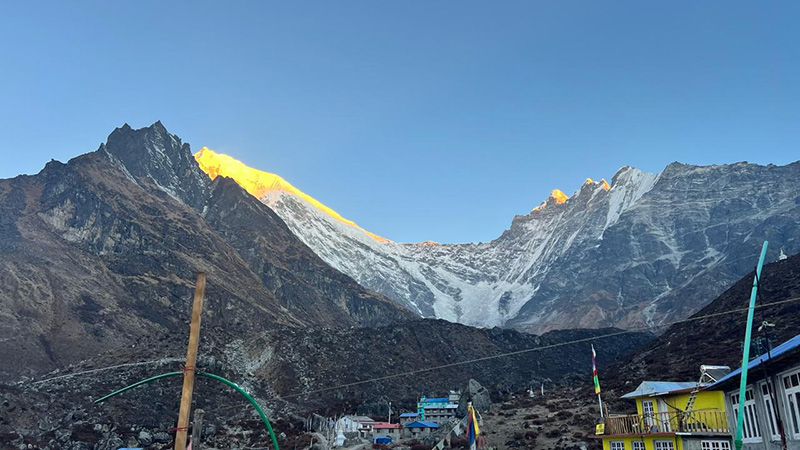
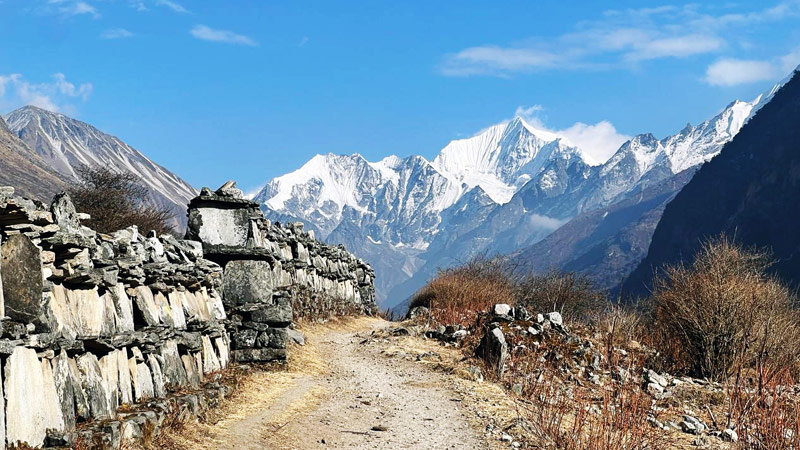
What to pack for Langtang Valley Trek
When preparing for the Langtang Valley Trek, it’s essential to pack wisely to ensure comfort, safety, and enjoyment throughout your journey. Here’s a brief guide on what to pack:
Clothing: Dress in layers with warm base layers, fleece jackets, waterproof outerwear, gloves, a hat, and a scarf.
Footwear: Sturdy hiking boots, wool socks, and gaiters for trekking comfort.
Sleeping Gear: Warm sleeping bag with a -10°C rating and a sleeping pad for a comfortable night’s rest.
Backpack: A sturdy backpack with a waist belt and 50-60L capacity for carrying essentials.
Trekking Poles: Reduce impact and improve balance during the trek.
Water: Water bottle and water treatment tablets or a filtration system for clean water consumption.
Illumination: Headlamp or flashlight for navigating in low-light conditions.
First Aid Kit: Include bandages, painkillers, anti-diarrhea medication, and personal medications for emergencies.
Sun Protection: Sunscreen, sunglasses, and a hat to shield yourself from the Himalayan sun.
Snacks: High-energy snacks like trail mix, energy bars, and chocolate for quick boosts of energy.
Shelter: A sturdy, lightweight tent is essential for camping during the trek.
Cooking Equipment: Portable stove, fuel, and cooking utensils for preparing meals on the trek.
Hydration System: A hydration pack or water bottles with insulating covers to prevent freezing at higher altitudes.
Navigation Tools: Map, compass, and GPS device to help navigate the trekking route accurately.
Emergency Equipment: Whistle, signal mirror, and emergency blanket for unexpected situations.
Toiletries: Toothbrush and toothpaste, hand sanitizer, wet wipes, and a quick-drying towel for personal hygiene.
Wildlife and Vegetation in Langtang Region
Langtang National Park’s variety and varied vegetation create a natural wonderland. The region’s plant and animal life is diverse, from temperate forests to alpine meadows and glaciers.
The lower Langtang Valley is covered with extensive rhododendron, oak, maple, and pine forests. These forests are home to Himalayan black bears, red pandas, thars, deer, and monkeys. Birdwatchers can see vivid pheasants, cuckoos, sunbirds, and majestic birds of prey flying overhead.
Alpine meadows bloom with wildflowers throughout spring and summer as the terrain rises. Yaks and other livestock kept by local populations graze in these high-altitude grasslands, demonstrating human-nature harmony.
Along with its unique flora and fauna, Langtang is known for its glacial features, including Langtang Lirung, the region’s highest peak, and several smaller glaciers. Ice giants nourish the region’s rivers and water supplies, supporting wildlife and humans.
After the 2015 earthquake, local communities, conservation organizations, and government agencies are working to rehabilitate and conserve the ecosystem. Langtang visitors see nature’s resilience and the communal effort to preserve its ecosystems.

